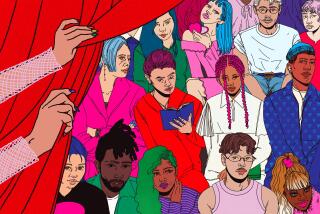A TV star looks at peer pressure among the foals
- Share via
NEW YORK — Young children live in their own worlds. They see the same people every day, do the same things and eat the same foods. Maybe they put ketchup or ranch dressing on pasta or pancakes and that’s considered normal -- in their little worlds.
Generally, all this routine is considered good because it makes children feel safe and comfortable with themselves and their loved ones.
A sheltered life, though, can have consequences later, both socially and academically.
A new book tackles diversity, couched in characters and words that kids can relate to.
Carson Kressley, the author of the picture book “You’re Different and That’s Super,” grew up in a fairly rural, blue-collar community in Pennsylvania, which he says was “not a place where difference is tolerated or celebrated.”
Kressley is best known as the fashion guru on Bravo’s “Queer Eye for the Straight Guy.”
He says he wrote the book largely based on his own feelings of being the odd boy out, being gay and being an equestrian rather than a team athlete. He can now joke that he was always the last one picked for the dodge ball team, but at the time it was hurtful. He also knows he wasn’t the first or last to go through it.
“This is for anyone who is skinny, fat, black, white, gay or straight -- anything that wreaks havoc with self-esteem,” Kressley says. “Sometimes kids have parents they can talk to, sometimes not. I want kids to know they’re not alone.”
In “You’re Different,” a young colt goes from being the most popular one on the farm to the most ostracized when he grows a single horn from the top of his head. Turns out the horse is a unicorn.
Even the unicorn thinks it’s a terrible thing to be different -- even though he has the whitest coat and most golden mane -- until his horn saves the day and everyone else celebrates his uniqueness.
Kressley used a horse barn as his analogy to the cafeteria table because, first of all, he knows horses well, down to their mannerisms, and, secondly, because they have a herd mentality. The book is the result of an idea he’s had in his head for a long time, he adds.
“Little kids don’t know about prejudice or social pressure. They get to be themselves ... but somewhere along the line, between 5 and 8, they start to feel peer pressure. For a kid, the perspective is so small and so limited, they don’t know about all the other people out there just like them.”
He acknowledges he’s an unlikely children’s book author because he’s not a parent and probably doesn’t have much of a fan base in the under-10 crowd. But, he says, “I was a kid once. The challenges are the same even if the circumstances are different.”
More to Read
Sign up for our Book Club newsletter
Get the latest news, events and more from the Los Angeles Times Book Club, and help us get L.A. reading and talking.
You may occasionally receive promotional content from the Los Angeles Times.










